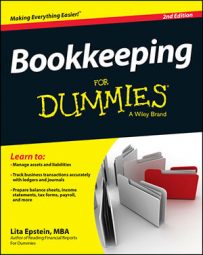After you close the Cash Receipts journal, the next step is to close the Cash Disbursements journal. Any adjustments related to outgoing cash receipts, such as bank credit-card fees, should be added to the Cash Disbursements journal.
Before you close the journal, you must also be certain that any bills paid at the end of the month have been added to the Cash Disbursements journal.
Bills that are related to financial activity for the month being closed but that haven’t yet been paid have to be accrued, which means recorded in the books, so they can be matched to the revenue for the month. These accruals are only necessary if you use the accrual accounting method. If you use the cash-basis accounting method, you only need to record the bills when cash is actually paid.
You accrue bills yet to be paid in the Accounts Payable account. For example, suppose that your company prints and mails fliers to advertise a sale during the last week of the month. A bill for the fliers totaling $500 hasn’t been paid yet. Here’s how you enter the bill in the books:
| Debit | Credit | |
|---|---|---|
| Advertising | $500 | |
| Accounts Payable | $500 |
To accrue the bill from Jack’s printing for June sales flyers.
This entry increases advertising expenses for the month and increases the amount due in Accounts Payable. When you pay the bill, the Accounts Payable account is debited (to reduce the liability), and the Cash account is credited (to reduce the amount in the cash account). You make the actual entry in the Cash Disbursements journal when the cash is paid out.
When proving out the cash, you should also review any accounts in which expenses are accrued for later payment, such as Sales Taxes Collected, to be sure all accrual accounts are up-to-date. These tax accounts are actually liability accounts for taxes that will need to be paid in the future. If you use the accrual accounting method, the expenses related to these taxes must be matched to the revenues collected for the month they’re incurred.

